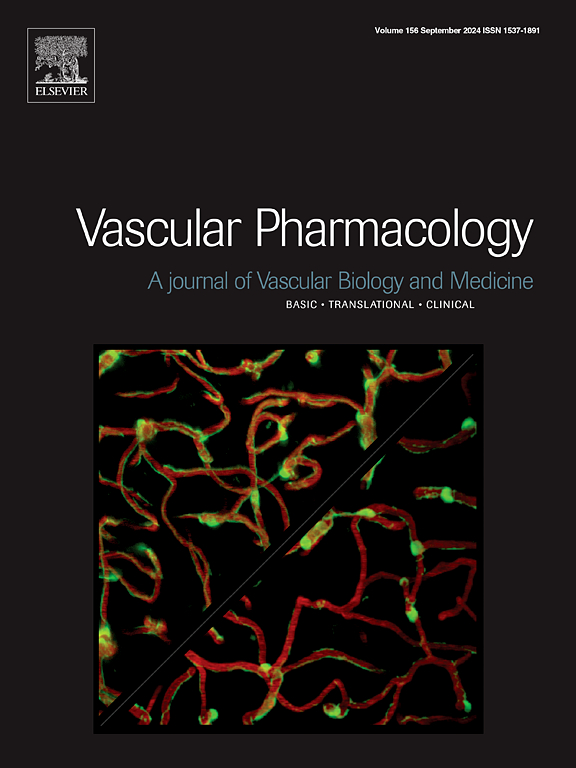动脉粥样硬化的表观转录组学:揭示RNA修饰、编辑和剪接及其在血管疾病中的意义
IF 3.5
3区 医学
Q2 PHARMACOLOGY & PHARMACY
引用次数: 0
摘要
动脉粥样硬化仍然是世界范围内发病率和死亡率的主要原因,由涉及基因调控和转录后过程的复杂分子机制驱动。新出现的证据强调了表观转录组学在动脉粥样硬化发展中的关键作用,研究RNA分子的化学修饰。表转录组学为血管健康提供了一个新的调控层,影响内皮细胞、平滑肌细胞和巨噬细胞的细胞功能,从而揭示了动脉粥样硬化的发病机制,并为新的治疗靶点提供了新的机会。这篇综述提供了对表转录组学的全面概述,重点是关键的RNA修饰,如n6 -甲基腺苷(m6A), 5-甲基胞嘧啶(m5C),假尿嘧啶(Ψ), RNA编辑机制,包括a -to- i和C-to-U编辑和RNA异构体。讨论了这些修饰在RNA稳定性、选择性剪接和microRNA生物学方面的功能意义,重点讨论了它们在炎症信号、脂质代谢和动脉粥样硬化斑块内血管细胞适应中的作用。我们还强调了这些修饰如何影响RNA异构体的产生,潜在地改变细胞表型并促进疾病进展。尽管表观转录组学有希望,但仍然存在重大挑战,包括检测复杂组织中RNA修饰的技术限制,以及需要更深入地了解其在动脉粥样硬化发病机制中的因果作用。将表转录组学与其他组学方法,如基因组学、蛋白质组学和代谢组学相结合,有可能提供对疾病更全面的了解。本文章由计算机程序翻译,如有差异,请以英文原文为准。

Epitranscriptomics in atherosclerosis: Unraveling RNA modifications, editing and splicing and their implications in vascular disease
Atherosclerosis remains a leading cause of morbidity and mortality worldwide, driven by complex molecular mechanisms involving gene regulation and post-transcriptional processes. Emerging evidence highlights the critical role of epitranscriptomics, the study of chemical modifications occurring on RNA molecules, in atherosclerosis development. Epitranscriptomics provides a new layer of regulation in vascular health, influencing cellular functions in endothelial cells, smooth muscle cells, and macrophages, thereby shedding light on the pathogenesis of atherosclerosis and presenting new opportunities for novel therapeutic targets. This review provides a comprehensive overview of the epitranscriptomic landscape, focusing on key RNA modifications such as N6-methyladenosine (m6A), 5-methylcytosine (m5C), pseudouridine (Ψ), RNA editing mechanisms including A-to-I and C-to-U editing and RNA isoforms. The functional implications of these modifications in RNA stability, alternative splicing, and microRNA biology are discussed, with a focus on their roles in inflammatory signaling, lipid metabolism, and vascular cell adaptation within atherosclerotic plaques. We also highlight how these modifications influence the generation of RNA isoforms, potentially altering cellular phenotypes and contributing to disease progression. Despite the promise of epitranscriptomics, significant challenges remain, including the technical limitations in detecting RNA modifications in complex tissues and the need for deeper mechanistic insights into their causal roles in atherosclerotic pathogenesis. Integrating epitranscriptomics with other omics approaches, such as genomics, proteomics, and metabolomics, holds the potential to provide a more holistic understanding of the disease.
求助全文
通过发布文献求助,成功后即可免费获取论文全文。
去求助
来源期刊

Vascular pharmacology
医学-药学
CiteScore
6.60
自引率
2.50%
发文量
153
审稿时长
31 days
期刊介绍:
Vascular Pharmacology publishes papers, which contains results of all aspects of biology and pharmacology of the vascular system.
Papers are encouraged in basic, translational and clinical aspects of Vascular Biology and Pharmacology, utilizing approaches ranging from molecular biology to integrative physiology. All papers are in English.
The Journal publishes review articles which include vascular aspects of thrombosis, inflammation, cell signalling, atherosclerosis, and lipid metabolism.
 求助内容:
求助内容: 应助结果提醒方式:
应助结果提醒方式:


